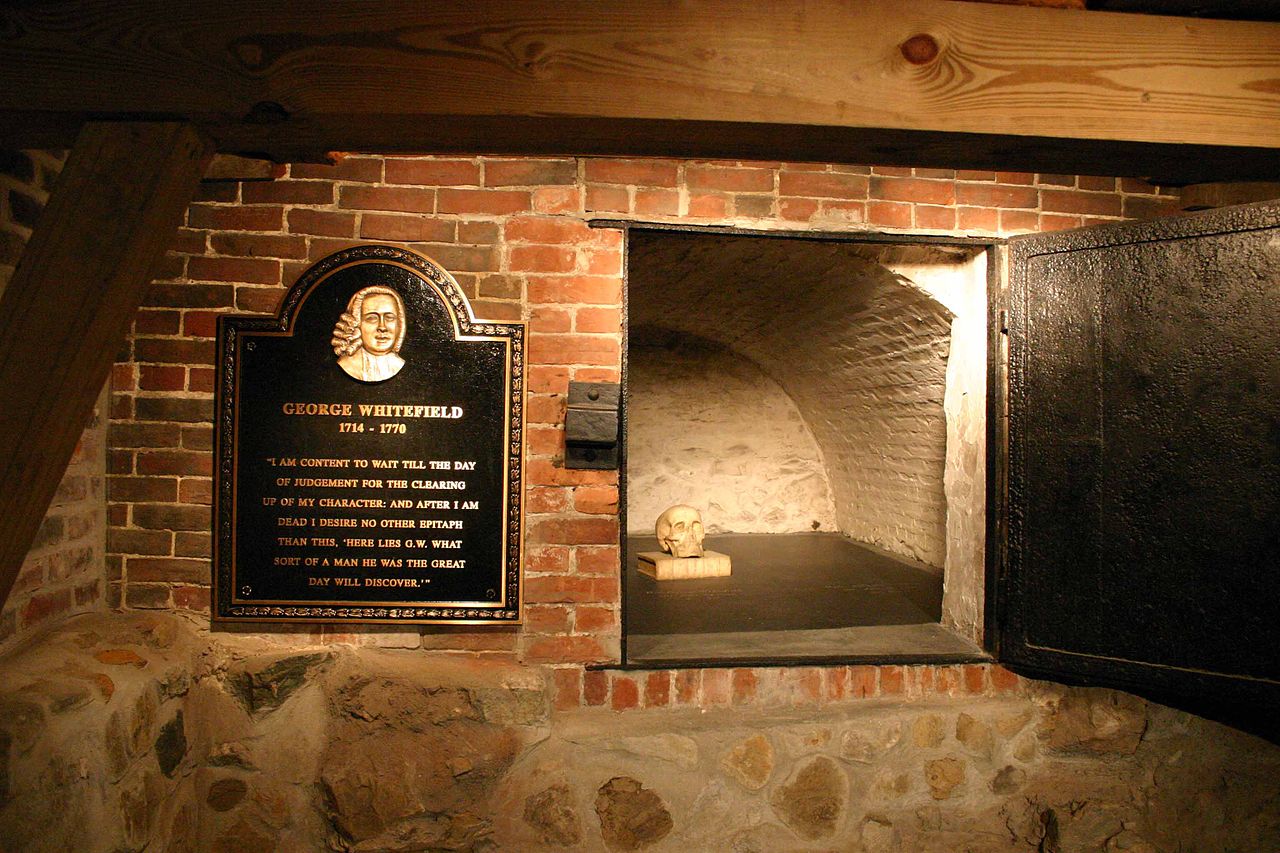
A Meditation on the Labor of Ministry
The church itself doesn’t look much different from countless other historic New England village churches—dingy white clapboard ornamented by a dingy white cupola and clock tower. (The steeple was damaged in a 1938 hurricane and never replaced.) It’s a little bigger than most, the sanctuary spacious and high-ceilinged with an ascendant altar and pulpit set in front of a dramatic arrangement of gold and white curtains and overlooking the many rows of boxed pews below. It’s the Old South Church in Newburyport, Massachusetts, and what it lacks in architectural uniqueness it more than makes up for in historical notoriety.
For one, the bell in the tower was hung by Paul Revere. And down in the bowels of the church, almost literally “buried beneath the pulpit,” is perhaps the greatest American preacher of the late 18th century and one of the leading figures—if not the leading figure—in the first Great Awakening, George Whitefield.
How he came to be placed in a crypt beneath the sanctuary of the Old South Church is a story well-told and easily found elsewhere. It’s the scene of the crypt itself I want to reflect on, as it has never ceased to entertain my pastoral imagination when I think of it.
I was never able to visit Whitefield’s final resting place when I was pastoring in New England, though I always wanted to. I have now visited the scene twice, both as part of the Midwestern Seminary New England study tour (occurring in the spring on odd years). The first time you see it, you may be a little underwhelmed. The crypt itself is nice enough, though it resembles a bit too much an old-world brick oven. If it weren’t for the replica of Whitefield’s white skull cast on top of a Bible, you might want to slide a pizza in there.
Do I sound irreverent? Well, picture this, then: You and maybe seven others (the space is small) make your way down a narrow, rickety staircase into the church furnace room. You and your fellow pilgrims must bow when you approach, not because of some penitent’s custom but because the ceiling is so low. It’s dark. It’s a little dank. There are cobwebs about, and the faint smell of mold in the cold subterranean air strikes the one accustomed to New England basements as utterly familiar.
The first thing you see may be the breaker box. Or a pile of traffic cones. Or boxes of church maintenance supplies for which no other room could be found. I’m always struck by the snow shovel leaning against the wall. And then there he is, beneath stone and brick, marked by a big plaque on the wall reading in gold Whitefield’s own last wish for his epitaph: “I am content to wait till the day of judgement for the clearing up of my character: and after I am dead I desire no other epitaph than this, ‘Here lies G.W. What sort of man he was the great day will discover’.”
I have photos of this plaque and of the crypt itself, a close up on his skull. I look at them probably more often than I’d like to admit. It is one of my favorite stops on the study tour, and I think the cramped furnace room with the snow shovel is part of that. I wish I had taken pictures of those things the last time I was there.
The space has become a symbol in my mind, of what I’m not entirely sure. Of ministry, I think. The glory is up top—the visible preaching, the dramatic archways and curtains of declaring the Lord’s word to gathering upon gathering of spiritual eyes and ears. But beneath the surface of what is seen is the unseen toil, the unceremonious dignity of routine maintenance and monitored electrical circuits and shoveled walkways—and, of course, of death.
It’s good, I think, that perhaps the greatest preacher in American history is laid to rest across from the church furnace underneath the church pulpit. It’s yet another reminder that “from dust we come, and to dust we shall return.” But it’s also a reminder—to me, anyway; your mileage may vary—that the greatest ministries are not made from great moments or great performances but from great faithfulness, even in the smallest of things.
There’s a cenotaph in the sanctuary, a great big (and to my eye) gaudy monstrosity commemorating Whitefield’s ministry right next to the pulpit. It looks like something out of a mausoleum. But his bones! His bones are in the basement.
What Whitefield said was true. Speculation aside, it is the great day when all will come out in the wash. Let us be content, then, to proclaim the full counsel of the Lord to all who will hear. And let our pulpits be built on our bones, not upon our glories or ambitions, but upon the reality that we are dying men preaching to dying men. Because great preaching isn’t fueled properly by great skills. Great preaching is fueled by the Spirit of the one who came humble and lowly, even as a servant to wash feet.
Fellow laborers in the gospel, it is fine to enjoy the glories of the sanctuary. But let’s not despise the ordinary labors of fixing and cleaning and clearing off. Those things lay under the pulpit too.
Let the reader understand.

